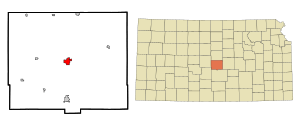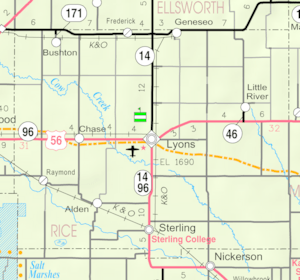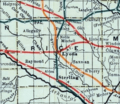Lyons, Kansas facts for kids
Quick facts for kids
Lyons, Kansas
|
|
|---|---|
|
City and County seat
|
|

Location within Rice County and Kansas
|
|

|
|
| Country | United States |
| State | Kansas |
| County | Rice |
| Township | Atlanta & Harrison |
| Founded | 1870 |
| Incorporated | 1880 |
| Named for | Freeman Lyons |
| Area | |
| • Total | 2.58 sq mi (6.70 km2) |
| • Land | 2.58 sq mi (6.70 km2) |
| • Water | 0.00 sq mi (0.00 km2) |
| Elevation | 1,693 ft (516 m) |
| Population
(2020)
|
|
| • Total | 3,611 |
| • Density | 1,399.6/sq mi (539.0/km2) |
| Time zone | UTC-6 (CST) |
| • Summer (DST) | UTC-5 (CDT) |
| ZIP code |
67554
|
| Area code | 620 |
| FIPS code | 20-43525 |
| GNIS ID | 485616 |
Lyons is a city in Kansas, United States. It is the main city and county seat of Rice County. In 2020, about 3,611 people lived there.
Contents
History of Lyons
Long ago, Native Americans lived in the land that is now Kansas. Some people believe that the explorer Coronado and his team camped near where Lyons is today. They were looking for a rich Native American place called Quivira.
West of Lyons, there is a cross honoring Juan de Padilla. He was part of Coronado's trip and later returned as a missionary. He is known as the first Christian martyr in North America, killed in 1542.
Kansas and Lyons Beginnings
In 1803, the United States gained most of modern Kansas through the Louisiana Purchase. Kansas became a U.S. state in 1861. Rice County was founded in 1867.
Lyons was first called Atlanta when it was founded in 1870. It was renamed Lyons in 1876. The city was named after Freeman J. Lyons.
Railroads and Growth
Lyons Main Street, which is U.S. Highway 56, follows the path of the old Santa Fe Trail.
In 1878, the Atchison, Topeka and Santa Fe Railway helped create a new railroad company. A branch line was built to Lyons in 1880. This railroad helped the city grow. Lyons officially became a city in 1880, the same year the train arrived.
Salt Mining and Baseball
In 1890, the Western Salt Company started mining salt in Lyons. This became an important industry for the city.
Lyons also had its own minor league baseball team called the Lyons Lions. They played from 1909 to 1913 in different leagues.
Geography
Lyons covers a total area of about 2.36 square miles (6.11 square kilometers). All of this area is land.
Climate
Lyons has a humid continental climate. This means it has warm summers and cold winters.
Population and People
| Historical population | |||
|---|---|---|---|
| Census | Pop. | %± | |
| 1880 | 509 | — | |
| 1890 | 1,754 | 244.6% | |
| 1900 | 1,736 | −1.0% | |
| 1910 | 2,071 | 19.3% | |
| 1920 | 2,516 | 21.5% | |
| 1930 | 2,939 | 16.8% | |
| 1940 | 4,497 | 53.0% | |
| 1950 | 4,545 | 1.1% | |
| 1960 | 4,592 | 1.0% | |
| 1970 | 4,355 | −5.2% | |
| 1980 | 4,134 | −5.1% | |
| 1990 | 3,688 | −10.8% | |
| 2000 | 3,732 | 1.2% | |
| 2010 | 3,739 | 0.2% | |
| 2020 | 3,611 | −3.4% | |
| U.S. Decennial Census | |||
2020 Census Information
In 2020, Lyons had 3,611 people living in 1,462 households. About 74.5% of the people were white. About 25.6% of the population was Hispanic or Latino.
About 25.4% of the people were under 18 years old. The average age in the city was 38.1 years.
2010 Census Information
In 2010, there were 3,739 people living in Lyons. About 85.7% of the residents were white. About 20.3% of the population was Hispanic or Latino.
About 25.8% of the residents were under 18 years old. The average age was 38.2 years.
Economy
The Lyons Salt Company and Compass Minerals are important businesses in Lyons. They are located on the southeast side of the city.
Education
Students in Lyons attend schools in the Lyons USD 405 public school district.
Notable People
Many interesting people were born in or lived in Lyons, including:
- William Borah (1865-1940), a U.S. Senator from Idaho
- Marshall Christmann (1976- ), a Kansas state legislator
- James Fankhauser (1939- ), a conductor and singer
- Orville Harrold (1878-1933), an actor and opera singer
- Shirley Knight (1938-2020), a Hollywood actress
- James Pulliam (1925-2005), an architect
- Marcia Rodd (1940- ), an actress
- Jerry Cox Vasconcells (1892-1950), a U.S. Army captain and World War I flying ace
- Milton R. Wolf (1971- ), a radiologist and Kansas politician
Images for kids
See also
 In Spanish: Lyons (Kansas) para niños
In Spanish: Lyons (Kansas) para niños


